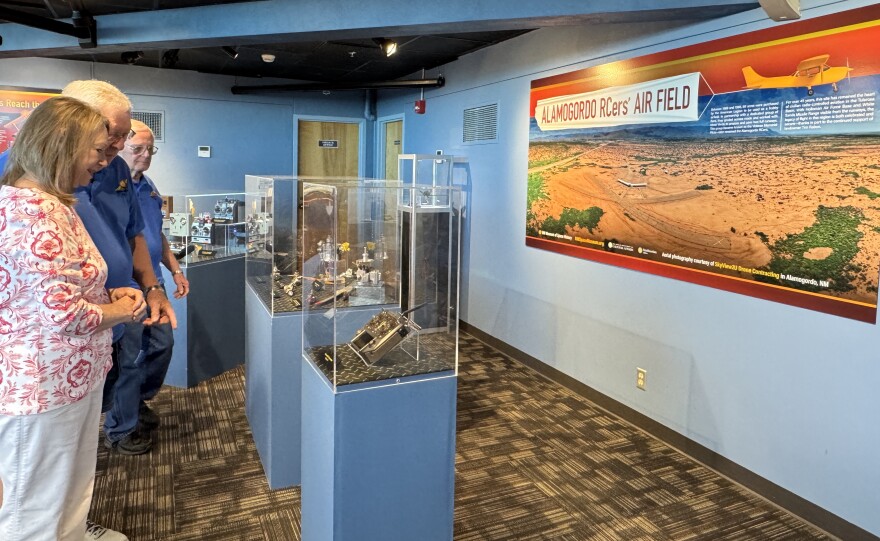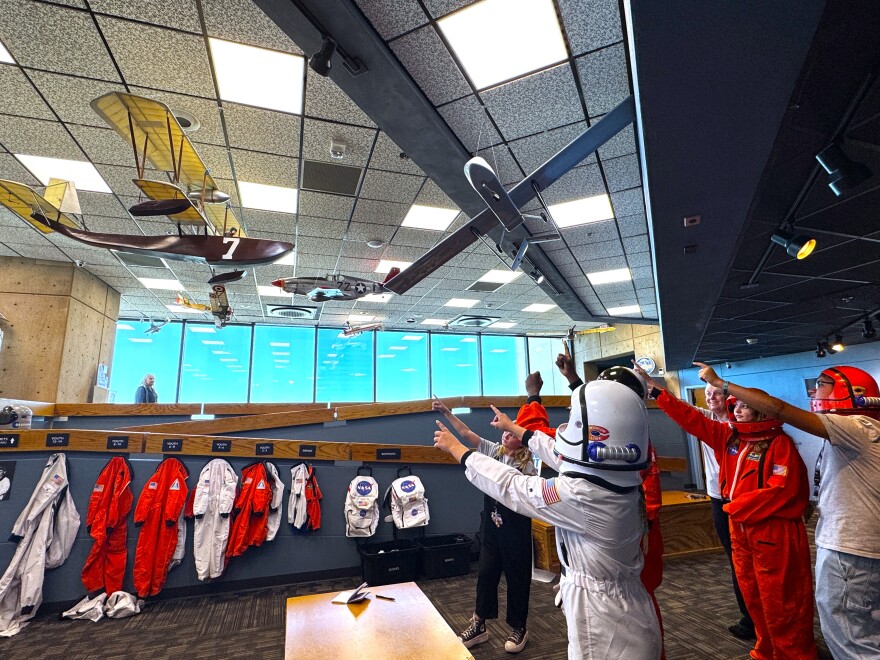“Skywired: The Story of Radio-Controlled Flight,” is the latest exhibit at the New Mexico Museum of Space History in Alamogordo. Scott Brocato spoke with Olga Valanos, public relations and marketing director for the museum, about the exhibit, which also pays homage to George V. Holloman, whose legacy lives on at Holloman Air Force Base.
Scott Brocato:
“Skywired” is a collaboration between the New Mexico Museum of Space History and the Alamogordo RCers. What are the Alamogordo RCers?
Olga Valanos:
So the Alamogordo RCers are a club here. It's remote-controlled aircraft and we have them in addition to the AMA, which is the Academy of Model Aeronautics. And they were formed in 1936 to do the National Aero Modeling Championships, where they would fly and compete their very first remote-controlled model airplanes.

Scott Brocato:
Now let's dive in into "Skywired.” Talk about what that exhibition will be about.
Olga Valanos:
So "Skywired” is an exhibit where we talk about the development of radio-controlled aviation. It's remote-controlled aircraft and so we go from the very beginning of creating radio transmission for long distance. So there would be a transmitter and a receiver, and that occurred in 1895 all the way till just three years later. Nikola Tesla demonstrated a radio-controlled boat, and then it goes all the way through the development of these remote-controlled crafts, all the way till today's modern warcraft, the drones. So in our exhibit there's actually some scale models of these warbirds. In addition, there's an interactive, where you can remotely fly a digital aircraft. It's a lot of fun. I just played with it today.

Our exhibit also includes The Big Guff, and it was made in 1937 by the Good brothers. They were twins. They designed a simple single-channel radio system using vacuum tubes and relays, and you can see the replica of it made by another set of hobbyists, Bill Lyon and Robert Moore. They were from El Paso, and they used plans from the 1937 edition of All Trails magazine. Of course, that plan was created by the Good brothers. The plane is in our museum, and it's one of only three of them in the entire world. The Big Guff was a spark ignition engine, and it had a radio control transmitter, a ham radio that was so big that it had to go into a truck. It had to be transported in the back of a pickup truck, so it's there at the museum for you to see it.
And a little cute detail: there's a cartoon of Goofy on the side of it. It's like the primitive Goofy from 1937. It's a really cool thing to see.
Scott Brocato:
The exhibit also pays homage to George V. Holloman, and his breakthroughs at Holloman Air Force Base were instrumental in transforming radio-controlled flight into a global phenomenon. Can you talk a little bit about George V Hollman? I mean, a lot of people have heard of Holloman Air Force Base, and some people, like me, don't know who it was named after.
Olga Valanos:
He came in after 1935, where a fellow named Reginald Denny, who was a Royal Air Force pilot from England at the end of World War One, he developed the radio plane O-Q1 for the Army. These kinds of unmanned aerial vehicles were used for target drone practice. So people would be on the ground shooting at these to help with their gunnery practices. So during that time, George Holloman--Captain George Holloman, Captain Carl Crane, and civilian technician Raymond Stout, were developing remote aircraft too, and they led a secret project called the Automatic Joe.
So what they did was, they fully automated the flight and landing of a modified Fokker C14B in 1937, and it was guided by a radio compass and autopilot. Before that, they actually achieved it. They won some awards. One of them was the prestigious Mackay Trophy for the most meritorious flight, and in 1939 he received the Distinguished Flying Cross.

Holloman continued to innovate the aerial weaponry and guided systems throughout World War II, but unfortunately, he died in a B17 crash in 1946, after which they honored him by changing the name of Alamogordo Army Airfield to what we know as Holloman Air Force Base. He laid the groundwork for today's MQ 9 Reaper drones that are used in a lot of wars now, saving a lot of lives and minimizing death. So yeah, he's very, very important.
Scott Brocato:
So when does “Skywired” end?
Olga Valanos:
It runs through all of this year until August the 1st of 2026. So it gives you plenty of time.
Scott Brocato:
Olga Valanos, thank you for talking with KRWG Public Media about this.
Olga Valanos:
Thank you so much for having me. I really appreciate it.



